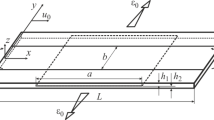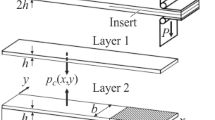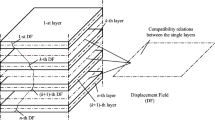A new method for a stress–strain analysis of layered composites, named the finite-layer method, is proposed, which is based on the consideration of each particular layer as a constituent of the entire laminate. This method serves as a unified approach to the development of new algorithms for computing stresses in composite layers, interlaminar contact stresses, large deflections, and critical buckling loads of thin-walled laminated structures with delaminations. The calculation of a laminated structure is reduced to solving a boundary-value problem for a system of first-order ordinary differential equations. The number of equations depends on the number of layers in the composite. The resolving system of differential equations is a stiff system. The stable numerical method of discrete orthogonalization is used for solving the boundary value problem. Part 1 is dedicated to the application of the proposed method to a linear analysis of free-edge stresses in composite laminates, to a study of the deformation of composite plates with delaminations and bending of composite beams with patches, and to calculations of adhesive joints.










Similar content being viewed by others
References
E. Hairer and G. Wanner, Solving Ordinary Differential Equations. II. Stiff and Differential-Algebraic Problems, Springer-Verlag, (1991).
S. K. Godunov, “Numerical solution of boundary-value problems for a system of linear ordinary differential equations,” Uspekhi Matem. Nauk, 16, No. 3, 171–174 (1961).
Ya. M. Grigorenko, Isotropic and Anisotropic Layered Shells of Revolution with a Variable Stiffness [in Russian], Nauk. Dumka, Kiev (1973).
Ya. M. Grigorenko and A. M. Timonin, “Approach to numerical solution of boundary-value problems in the theory of shells in coordinates of general form,” Int. Appl. Mechanucs, 30, No. 4, 257–263 (1994).
Ya. M. Grigorenko and A. T. Vasilenko, “Solution of problems and an analysis of the stress–strain state of anisotropic inhomogeneous shells (Review),” Prikl. Mekh., 33, No. 11, 3–38 (1997).
A. N. Guz’ (ed.), Composite Mechanics. In 12 Vols. Vol. 11. Ya. M. Grigorenko, Yu. N. Shevchenko, V. G. Savchenko, et al. (eds.), Numerical Methods [in Russian], “ASK,” Kiev (2002).
Ya. M. Grigorenko, “Solution of boundary-value problems on the stress state of elastic bodies of complex geometry and structure by using discrete Fourier series (Review),” Prikl. Mekh., 45, No. 5, 3–53 (2009).
A. V. Karmishin, V. A. Lyaskovets, V. I. Myachenkov, and A. N. Frolov, Statics and Dynamics of Thin-Walled Shell Structures [in Russian], Mashinostroenie, Moscow (1975).
V. I. Myachenkov (ed.), Calculations of Engineering Structures by the Finite-Element Method. Handbook [in Russian], Mashinostroenie, Moscow (1989).
V. V. Novozhilov, Fundamentals of the Nonlinear Theory of Elasticity [in Russian], Gostekhizdat, Leningrad (1948).
S. Timoshenko, S. Woinowsky-Krieger, Theory of Plates and Shells, McGraw-Hill, (1959).
L. F. M. da Silva, P. J. C. das Neves, R. D. Adams, and J. K. Spelt, “Analytical models of adhesively bonded joints. Part I: Literature survey,” Int. J. Adhes. Adhesives, 29, 319–330 (2009).
Author information
Authors and Affiliations
Corresponding author
Additional information
Translated from Mekhanika Kompozitnykh Materialov, Vol. 49, No. 3, pp. 339–356 , May-June, 2013.
Rights and permissions
About this article
Cite this article
Timonin, A.M. Finite-Layer Method: a Unified Approach to a Numerical Analysis of Interlaminar Stresses, Large Deflections, and Delamination Stability of Composites Part 1. Linear Behavior. Mech Compos Mater 49, 231–244 (2013). https://doi.org/10.1007/s11029-013-9339-1
Received:
Published:
Issue Date:
DOI: https://doi.org/10.1007/s11029-013-9339-1




